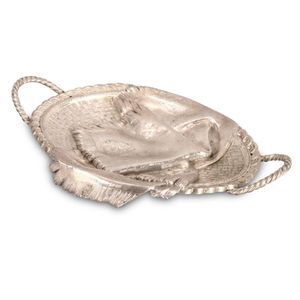Russian Silver Trompe L'oeil Bread Basket by Ovchinnikov
Russian silver Trompe L'oeil bread basket, marked Pavel Ovchinnikov, 84, 1888, assayer Anatoly Apollonovich Artsybashev, Moscow, later impressed sterling silver, of oval form, with simulated draped cloth over simulated raffia body, flanked by twist handles and four wirework feet, total weight 375gm, length 28.5 cm. Provenance: Sotheby's, Belgravia, lot 175 2/12/76, then by family descent
You must be a subscriber, and be logged in to view price and dealer details.
Subscribe Now to view actual auction price for this item
When you subscribe, you have the option of setting the currency in which to display prices to $Au, $US, $NZ or Stg.
This item has been sold, and the description, image and price are for reference purposes only.
- Bread Basket - Bread baskets were commonly used from the 17th to the 19th centuries in Europe and America as a serving piece at formal meals. In the early 17th century, bread baskets were made of wood, pewter and later silver as it was an expensive and prestigious material and demonstrated off the host?s wealth and status.
These bread baskets were usually oval or circular in shape, and were typically decorated with intricate engravings, embossing, and other decorative details. Some were plain and simple, while others were quite ornate, featuring raised scrollwork, beading, or other decorative motifs. Those made in the early 17th century tend to have two handles but surviving examples are rare. From the mid 1770s they usually have a central swing handle. The handles were typically ornate and often curved or scrolled. The shape and size of these baskets varies; some are large, meant to hold multiple loaves, others are more compact and meant for one loaf. By the 18th century, most bread baskets were made of silver. - Sterling Silver - Sterling silver is a mixture of 92.5% pure silver and 7.5% of another metal, usually copper. Fine silver is 99.9% pure silver, and is relatively soft and the addition of the very small amount of copper gives the metal enough strength and hardness to be worked into jewellery, decorative and household objects.
- Trompe L'oeil - Literally translated from the French, trompe l'oeil means "to deceive or trick the eye" and describes works whose subjects are presented so realistically that the viewer of the artwork or object believe they are looking at a three-dimensional object.
This item has been included into following indexes:
- Russian
